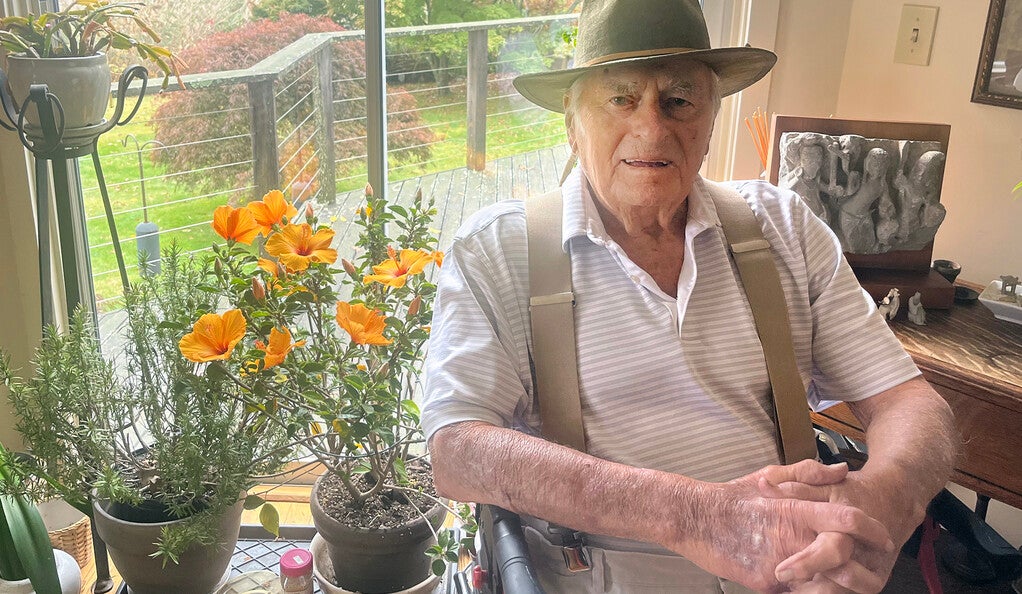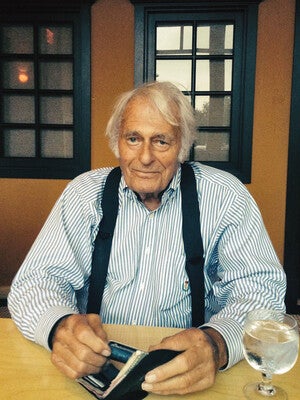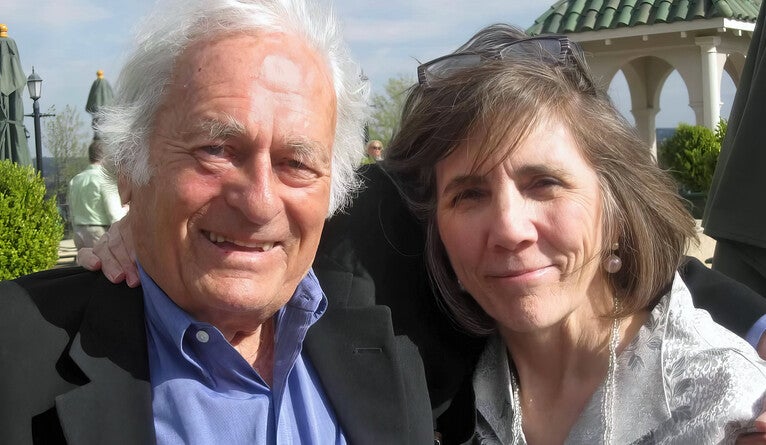A century of discovery, and still seeking

Robert G. Shulman, Sterling Professor Emeritus of Molecular Biophysics and Biochemistry in Yale’s Faculty of Arts and Sciences and Yale School of Medicine. (Image courtesy of Stephanie Spangler)
Last summer, Yale biophysicist Robert G. Shulman co-authored a paper that demonstrated that metabolism has a greater, and earlier, impact on adaptation than previously understood. The findings, published in the journal Frontiers in Cell and Developmental Biology, offered a major new insight into how evolution works.
“In evolution, they’ve been thinking that it’s all from the gene, but no, it’s from the gene working with the metabolism that exists in the body,” Shulman, Sterling Professor Emeritus of Molecular Biophysics and Biochemistry in Yale’s Faculty of Arts and Sciences (FAS) and Yale School of Medicine (YSM), said recently. “What has thrilled me is that it changes what the field of biochemistry should include.”
It would be a remarkable achievement on its own, but it follows nearly eight decades of major contributions to a host of scientific disciplines: in developing nuclear magnetic resonance techniques in live subjects, in defining metabolic pathways, in understanding brain function through spectroscopy.
And Shulman’s desire to push forward his field continues, even as, in early March, he celebrated one more major milestone: his 100th birthday.
“He is still making major contributions to paradigm shifts in biology,” said Douglas Rothman, a former student of Shulman’s who is now co-director of the Magnetic Resonance Research Center (MRRC) at YSM and professor of radiology and biomedical imaging and of biomedical engineering — and a frequent co-author with Shulman.
“What’s always driven him is his quest to really understand, first materials, then biology, then cognition, evolution, adaptation — always fundamental questions.”

Shulman joined the Yale faculty in 1979, after working for many years at Bell Laboratories, where he headed the Biophysics Research Department. At Yale, he founded and then directed the MRRC, making the university one of the early leaders in magnetic resonance (MR) technology, and served as Director of the Division of Biological Sciences in FAS. He is also an elected member of the National Academy of Sciences and the National Academy of Medicine.
And in his teaching and lab work, he mentored many students who went on to make their own foundational contributions to magnetic resonance applied to medicine.
“He is a true scientist in the broadest definition but also in the narrowest definition,” said D. S. Fahmeed Hyder, a former student and now professor of biomedical engineering at the Yale School of Engineering & Applied Science and professor of radiology and biomedical imaging at YSM. “He could be hands-on, if he chose to, but he was also very hands off, to allow people to bring their own ideas and their own perspectives.”
Throughout his career, Rothman said, Shulman has been an iconoclast in his field, pushing against truisms and refusing to accept theories as proofs. As Shulman once wrote, he didn’t hold with “the image of scientists sitting at their desks analyzing data and then every so often moving to the salami of truth hanging in their office to cut a slice for publication.”
His recent work takes the same tack — applying new means of analysis to data sometimes gathered years ago, in order to find fresh insights into what most considered settled questions.
“If you just follow the main paradigmatic direction in science, it’s not very interesting,” Shulman said. “In science, I’ve very much chosen the minority path.”
‘A creative process’
While Shulman always intended to pursue science, a formative intellectual experience came through the humanities, when, as an undergraduate at Columbia University, he was a student and mentee of Lionel Trilling, the preeminent literary critic.
“Reading and discussing under his guidance was a miraculous education,” Shulman later recalled, and the creativity he found in literature became both a lifelong interest and informed his approach to pure science.
A second formative experience was in the lab of Francis Crick, one of the founders of molecular biology. After earning his Ph.D. in chemistry at Columbia, Shulman worked in solid-state physics at Bell Labs for a decade before using a Guggenheim fellowship to spend a sabbatical year at Cambridge working with Crick’s lab.
“That started me on the career I’m on,” said Shulman — adapting the techniques of physics to biological study. After another spell at Bell Labs, where he helped pioneer the use of spectroscopy in living subjects, he moved to Yale “because I wanted a magnet large enough to take people” and because he was keen to work with colleagues like Peter Moore, now Sterling Professor Emeritus of Chemistry, and Donald Engelman, now Eugene Higgins Professor of Molecular Biophysics and Biochemistry.
And, he added, “I’d always loved Yale.”
During his tenure at the university, his collaborations brought several major insights into the role of metabolism and bioenergetics in medical science, including diabetes, cardiology, and neurological disorders. He pioneered the use of MR technology in studying the brain’s activity and demonstrated that it could trace metabolic functioning in the brain — studies that have helped reevaluate how the brain uses energy even while at rest.
He also made fundamental contributions to the basic understanding of metabolism itself, through the discovery of the glycogen shunt and its role in allowing metabolism to adapt to sudden challenges by stabilizing multiple metabolic pathways.
“One of his remarkable abilities is to both really understand where the important problems are that MR technology or spectroscopy in general can answer and seeing into the future how that will happen, how the technology will develop and how the questions could be answered,” said Rothman.
At Yale, Shulman also found opportunity to reengage with the humanities, becoming one of the first fellows at the Whitney Humanities Center (WHC), which was established in 1981 as a hub for research and scholarly exchange.
“I realized very quickly that this was one very smart man and not just in his field of biology — he knew lots of things outside of his field, and he was very much interested in the humanities,” said Peter Brooks, Sterling Professor Emeritus of Comparative Literature and founding director of the WHC. “The center was in its fledgling state, and it needed people like Bob to believe in it and to make it happen. He was very important in defining its mission and its structure.”
Each week, the fellows — who included Owen Fiss, now Sterling Professor Emeritus of Law, and the late William W. Hallo, who was the William M. Laffan Professor Emeritus of Assyriology and Babylonian Literature — held far-ranging discussions on their research and interests.
“They were all deeply interested in their own subjects, as I was interested in biophysics,” said Shulman. “And then I realized that the interest they had was similar to an interest I had been developing over the years in science, which was, how does it happen? How do you do it? Why does it come out this way? It’s the creative process of deciding where you’re going, what you’re doing.”
His interest in exploring the creative commonalities between the humanities and science took concrete form in an undergraduate course called “Literature and Science,” which he taught for several years with the late J. Michael Holquist, a professor of comparative literature. Readings included Wallace Stevens, Ivan Turgenev, and Thomas Kuhn; an essay from Oscar Wilde, Shulman wrote, showed the disciplines’ “shared simplicity of creating something that had never before existed.”
“This is a person who spans an incredible breadth of knowledge and interests, from the sciences all the way across to the humanities.” said Alison Richard, the Franklin Muzzy Crosby Professor Emerita of the Human Environment and former provost of Yale. “And his vision is not only interdisciplinary but also encompasses different ways of thinking about what’s important.”
In recognition of Shulman’s role as a champion of this integration, the WHC established the Shulman Lecture Series, which brings forward lectures on topics bridging science and the humanities, organized in conjunction with an undergraduate seminar course.
“He keeps thinking forward,” said Brooks. “And he’s still coming up with new ideas and looking for new syntheses of ideas. He’s really quite amazing that way.”
A continued quest for understanding
While Shulman officially retired from Yale in 2002, his work continued. And through his close collaborators at Yale and his wife, Stephanie Spangler, vice provost for health affairs & academic integrity, he remains strongly connected with university life.
“Being married to Bob is a blessing without measure,” said Spangler. “He has expanded my appreciation of scientific research, deepened my familiarity with the humanities, and, every day, continues to enrich my experience of life and love and Yale.”

His recent scientific analyses have continued to point to major shifts in the understanding of metabolic function and brain activity. With Rothman, he helped discover how cells convert glucose to ethanol and lactate, commonly known as the Warburg effect, which had long been a mystery of metabolic science; proposed a new approach to understanding how mental processes in the brain occur; and probed the relationship between metabolism and genetics.
His 2013 book, “Brain Imaging: What It Can (and Cannot) Tell Us About Consciousness,” overlaid philosophy of science onto an examination of the technical capabilities and limitations of functional magnetic resonance imaging to study cognitive process such as memory and behavior.
One of Shulman’s great strengths as a scientist, said Hyder, is that he writes about complex and specialized findings in a way that feels accessible to a larger audience. It’s not easy to do, he said, and that challenge inspired Hyder to design his own course on scientific dissemination.
“We use a textbook that Bob helped put together that’s a few years old now, but it’s perfect for the class because the students get to see how quickly various disciplines develop and keep on developing,” Hyder said. “And students love it because they learn it’s very important to write in a manner that is understandable across scientific disciplines.”
After more than 70 years in science, Shulman remains enthralled by his research — and gratified at the prospect of reunifying areas of study that had drifted apart.
In his most recent work with Rothman, he points out, they’ve demonstrated that the plasticity of the proteins that synthesize and breakdown glycogen allows organisms to rapidly adapt to changes in their environment, previously believed to be due almost solely to gene expression. They further showed, in collaboration with Peter Moore, that gene expression, which occurs later, depends on the initial metabolic plasticity — a finding that bridged a division within biochemistry and molecular biology, which tend to study either proteins or DNA, respectively, not both.
“Plasticity has brought them back together,” Shulman said. “Fundamentally, the discovery is the healing of the biological studies, which have been in danger of diverging and not having anything to do with each other.”
It’s work that has preoccupied him for decades — even against the prevailing winds of his field.
“For many years Bob was the lonely voice in the wilderness,” said Rothman. “Bob from the beginning didn’t accept that gene expression alone controlled everything, even though almost all other scientists at the time did. He didn’t find anything conclusive when he looked at metabolism in the ’70s, but he kept at it. And now we’ve learned fundamental things about the brain, about diabetes, [and] carbohydrate metabolism.
“Throughout his career he has made groundbreaking discoveries using spectroscopy that really had fundamental impact on medical science, and he is still making a major impact.”